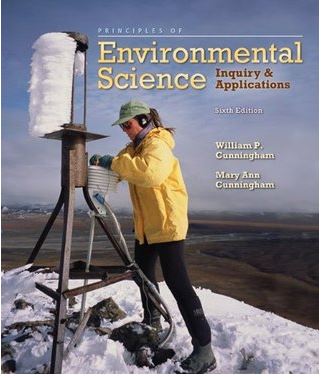
Principles of Environmental Science 6th Edition by William Cunningham, Mary Cunningham
Edition 6ISBN: 978-1121779211
Principles of Environmental Science 6th Edition by William Cunningham, Mary Cunningham
Edition 6ISBN: 978-1121779211 Exercise 9
Examining Nutrients in a Wetland System
As you have read, movements of nitrogen and phosphorus are among the most important considerations in many wetland systems, because high levels of these nutrients can cause excessive algae and bacteria growth. This is a topic of great interest, and many studies have examined how nutrients move in a wetland, and in other ecosystems. Taking a little time to examine these nutrient cycles in detail will draw on your knowledge of atoms, compounds, systems, cycles, and other ideas in this chapter. Understanding nutrient cycling will also help you in later chapters of this book.
One excellent overview was produced by the Environmental Protection Agency. Go to this website and download a PDF document of the study: http://www.epa.gov/waterscience/criteria/nutrient/guidance/wetlands/index.html. If you prefer, you can also look at just one chapter at a time on this website.
Figure 1 A detailed schematic diagram of the nitrogen cycle in a wetland. Study the online original to fill in the boxes. Source: EPA Nutrient Criteria Technical Guidance
Manual www.epa.gov/waterscience/criteria/nutrient/guidance/.

Find chapter 2, An Overview of Wetland Science, and answer the following questions:
Now look at the next page, with the photograph. What are the sources from which nutrients enter a wetland? Think of at least three ways in which human activities can increase these sources.
As you have read, movements of nitrogen and phosphorus are among the most important considerations in many wetland systems, because high levels of these nutrients can cause excessive algae and bacteria growth. This is a topic of great interest, and many studies have examined how nutrients move in a wetland, and in other ecosystems. Taking a little time to examine these nutrient cycles in detail will draw on your knowledge of atoms, compounds, systems, cycles, and other ideas in this chapter. Understanding nutrient cycling will also help you in later chapters of this book.
One excellent overview was produced by the Environmental Protection Agency. Go to this website and download a PDF document of the study: http://www.epa.gov/waterscience/criteria/nutrient/guidance/wetlands/index.html. If you prefer, you can also look at just one chapter at a time on this website.
Figure 1 A detailed schematic diagram of the nitrogen cycle in a wetland. Study the online original to fill in the boxes. Source: EPA Nutrient Criteria Technical Guidance
Manual www.epa.gov/waterscience/criteria/nutrient/guidance/.

Find chapter 2, An Overview of Wetland Science, and answer the following questions:
Now look at the next page, with the photograph. What are the sources from which nutrients enter a wetland? Think of at least three ways in which human activities can increase these sources.
Explanation
In biological system, nutrients are recy...
Principles of Environmental Science 6th Edition by William Cunningham, Mary Cunningham
Why don’t you like this exercise?
Other Minimum 8 character and maximum 255 character
Character 255


